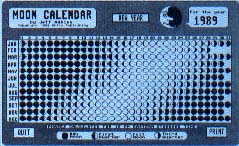ON DISK!
Moon Calendar
by Jeff Adkins
Observing the moon has been one of humankind's most enduring passions. START helps you continue this tradition with its Moon Calendar, a simple but educational program that actually charts the various phases of the moon for any given year. Moon Calendar can run in either medium or high resolution.
Predict the next full moon with your ST! File MOON.ARC on your START disk.
The moon has always held a certain fascination for me. As a child gazing up at a full moon, I wondered if it really was made of cheese. And if I squinted hard enough, I swore I could see the mythical man overlooking his lunar domain.
As I grew older, my fascination with the moon only increased. Certain myths were shattered to be replaced by questions. Astronomy became a hobby I embraced with marked enthusiasm. Observing the moon is great fun, and that's why I developed Moon Calendar for the ST. With Moon Calendar you can generate a chart of the various phases of the moon for any year from 1985 on. The program was written in GFA BASIC 2.0 and runs in either medium or high resolution.
Running Moon Calendar
To run Moon Calendar, copy the files MOON.ARC and ARCX.TTP onto a blank, formatted disk. Un-ARC MOON.ARC following the Disk Instructions elsewhere in this issue. Double click on MOON.PRG to start the program.
The first thing you see after starting the program is a text screen that asks you to type in a year (1985 or later). After you've typed in the desired year press Return.
 |
Moon Calendar charts the phases of the moon for any year from 1985 on. Among its predic- tions for 1989: a new moon on Independence Day, Halloween and Christmas. |
The program will then automatically calculate the phases of the moon on each day of your chosen year. A frame will appear on the screen and then MOON.PRG will draw the moon's phases. Note that for monochrome monitors MOON.P13 must be in the same directory, for color monitors MOON.PI2 must be in the same directory. Easy!
Click on Print to do a screen dump of the image to your printer. Make sure your printer is turned on and ready. To compute the phases of a different year, click on New Year. Click on Quit to exit the program.
How the Calendar Calculates the Moon's Phases
The moon's phase-cycle (from full to new) occurs over a period of about 29-1/2 days. Moon Calendar starts from a set phase and time, in this case the new moon that occurred on December 31, 1984. It then adds the number of hours from that time to the year you selected. The phase for each day of the year is then determined by dividing the number of hours since the base phase (December 31, 1984) by the number of hours in a cycle of phases (calculated by multiplying 29-1/2 days by 24 hours in a day). The result is what you see on the screen.
Note: Moon Calendar calculates the moon's orbit as a circle; it is actually an elipse. As a result, some deviation in phases may occur for dates beyond the year 2000. To do a quick fix, simply establish a new benchmark year every decade following the instructions contained in the REM statements.
Moon Calendar is a simple program that saves all you budding astronomers the time and energy it takes to dig through almanacs and complex charts just to find out when the next full moon will occur. Werewolves will find it especially helpful in planning their schedules for the coming years.
Download MOONCAL.STJeff Adkins teaches high school astronomy and physics in Lexington, Kentucky. This is his first published program in START.